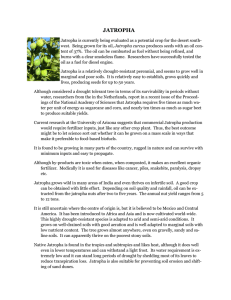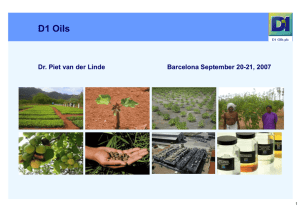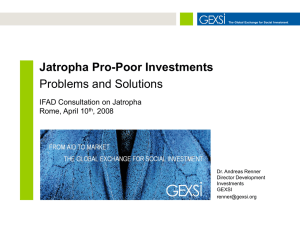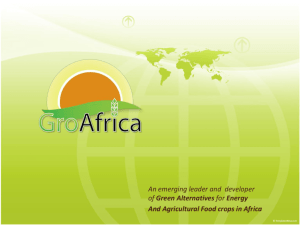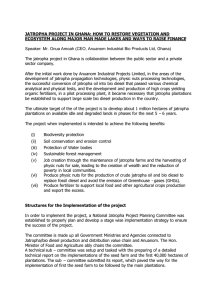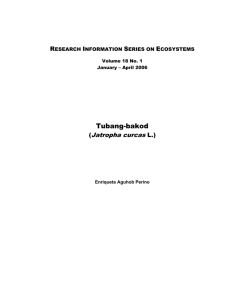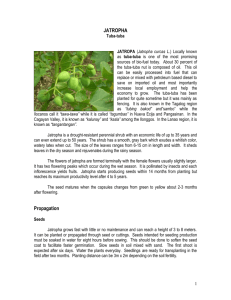Jatropha - The Franke Institute for the Humanities
advertisement
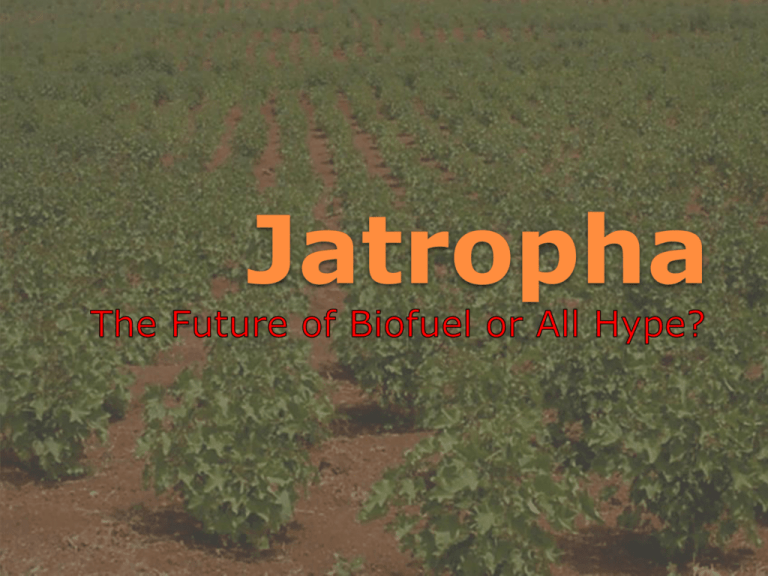
Jatropha …About the plant Jatropha is a genus of about 175 plants. When people refer to Jatropha as a biofuel they are speaking of Jatropha curcas. It is a hardy, drought and pest-resistant plant. It produces seeds containing up to 40% oil. Botanical features: ◦ Large green to pale-green leaves ◦ Flowering plant ◦ Fruits are produced in winter or throughout the year depending on temperature and soil moisture. ◦ Seeds become mature when the capsules change from green to yellow. Grows almost anywhere including wastelands, gravelly, sandy, and saline soils. It can thrive on even some of the poorest stony soil and will grow in crevices of rocks. Complete germination is achieved within 9 days. Survives and thrives on a mere 250 mm (10 inches) of rain a year. Ploughing and planting are not needed regularly since the shrub will continue to grow for about forty years. • The plant responds negatively to organic fertilizers like manure during germination. • The use of pesticides are not necessary due the pesticidal, poisonous, and fungicidal properties of the plant. • Begins yielding after 9-12 months. However, effective yield comes only after 2-3 years. Easy Cultivation Where Does it Grow? Jatropha is native to Central America but it has become naturalized India, Africa, North America and parts of Asia New uses for land in India: Government Focus: India's Planning According to the Ministry of Rural Development, only 173 million of 306 million hectares of land are used for cultivation, while the remaining land is either eroded farm land or non-arable wasteland. Such previously unused land can be used for Jatropha. Commission recommended a national mission on biofuel, specifically Jatropha: ◦ Stage 1 - 500,000 hectares of jatropha grown on government land across the country. The fuel would be produced at the village level by local governing bodies. ◦ Stage 2 - India's central government would plant a total of 12 million hectares of the plant and privatizing the production of jatropha biodiesel Focus on India The Production Process Why Focus on Jatropha? The Perfect Storm: High oil prices – force a search of possible long-term alternatives to run automobiles. Climate change – motivates people to seek green energy sources Food prices – necessitate alternative energy (specifically biofuel sources) that do not tradeoff with food producing crops. Recent Attention: International speculation – in December of 2007, Goldman Sachs identified Jatropha as a potentially strong source of biofuel for the future. Growing investment in India, China and Africa – has made this created a lot of hype around the possible fuel source. European companies looking for new fuel sources – are considering a turn to Jatropha. Why the paper…. - Our Question – Navigating Uncertainties A good deal of uncertainties exist when it comes to Jatropha as a biofuel source. These uncertainties can be grouped into two categories: 1. Production and Refinery Uncertainties – - Lack of domestication of the plant. - What to do with the biproduct of the plant. - Varying estimates of oil yield from the seed. - Oil production based on where the crop is grown. - How much carbon does production cost? 2. Economic and Political Viability Uncertainties - Viability of and differences with large scale production. - Whether government subsidy is necessary (like in India) - Food production tradeoff? Varying Output Figures One of the greatest Uncertainties with Jatropha is how much oil is produced per acre of plants. The existing numbers on this are often suspect and vary widely. For instance, India’s planning commission thinks it would be about 1,300 liters of oil per hectare. Pushpito Ghosh, director of the Central Salt and Marine Chemicals Research Institute, says its half that. These discrepancies are due in some part to who is doing the research. A good deal of these estimates come from sources who are invested in Jatropha. This paper is a more leveled study. Cost of production One of the greatest concerns when it comes to biofuels is the cost per barrel of fuel. Recent studies have shown that ethanol, for instance, has huge costs in the refining stages which ultimately render it inefficient without large government subsidies. A central question for this paper is whether the cost to produce Jatropha makes it inefficient without subsidy or whether the fuel source could exist in the free market without government support. Estimated Cost of Jatropha Cultivation (U.S.) 1600 Jatropha Trees Per Hectare Year 1 Year 2 Year 3 Year 4 Year 5 Total Site Preparation (14 man-days) 210 - - - - 210 Conservation Tillage (15 man-days or tractor) 225 - 250 - 270 745 Alignment & Stalking (10 man-days) 150 - - - - 150 Digging, Planting & Refilling Pits (60 man-days) 900 - - - - 900 Fertilizers & Bio-Pesticides (0.200 Kg./Tree) 600 630 660 690 730 3,310 Cost of Plants 1st Year (US$0.50 per plant) 800 - - - - 800 Re-Planting 1st Year (15%) 135 - - - - 135 Maintenance & Irrigation (50 man-days) 750 790 830 870 910 4,150 Harvesting & Pruning (50 man-days) 750 790 830 870 910 4,150 Contingencies 140 140 140 140 140 700 - 90 - - - 90 120 80 - - - 200 4,780 2,520 2,710 2,570 2,960 15,540 Re-Planting 2nd Year (10%). Plants for Re-Planting 1st & 2nd Years Total Source: LOZANO CDM Proposal

